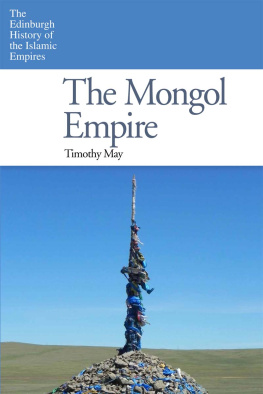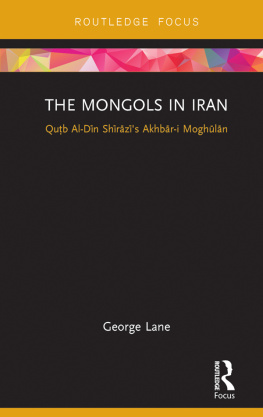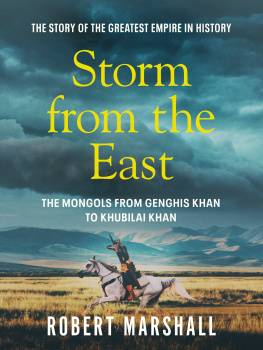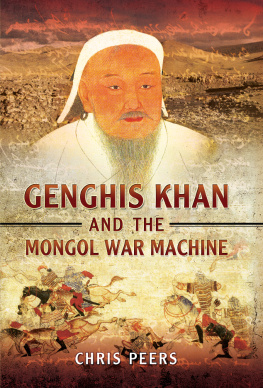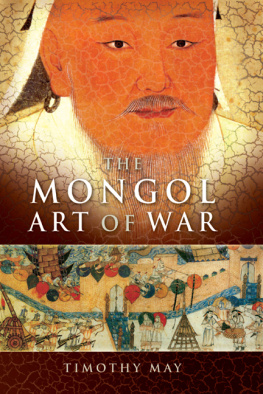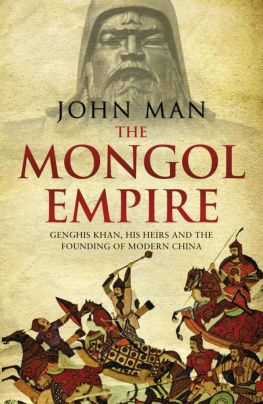The Mongol Empire
Recent Titles in Empires of the World
The Persian Empire: A Historical Encyclopedia
Mehrdad Kia
The Spanish Empire: A Historical Encyclopedia
H. Micheal Tarver, editor, Emily Slape, assistant editor
THE MONGOL
EMPIRE
A Historical Encyclopedia
Volume 1
Timothy May, Editor
Empires of the World

Copyright 2017 by ABC-CLIO, LLC
All rights reserved. No part of this publication may be reproduced, stored in a retrieval system, or transmitted, in any form or by any means, electronic, mechanical, photocopying, recording, or otherwise, except for the inclusion of brief quotations in a review, without prior permission in writing from the publisher.
Library of Congress Cataloging-in-Publication Data
Names: May, Timothy Michael, editor.
Title: The Mongol empire : a historical encyclopedia / Timothy May, editor.
Description: Santa Barbara, California : ABC-CLIO, 2017. | Series: Empires of the world | Includes bibliographical references and index.
Identifiers: LCCN 2016011019 | ISBN 9781610693394 (set : alk. paper) | ISBN 9781440846298 (volume 1 : alk. paper) | ISBN 9781440846304 (volume 2 : alk. paper) | ISBN 9781610693400 (eISBN)
Subjects: LCSH: MongolsHistoryTo 1500Encyclopedias.
Classification: LCC DS19 .M589 2017 | DDC 950/.203dc23 LC record available at http://lccn.loc.gov/2016011019
ISBN: 978-1-61069-339-4 (set)
978-1-4408-4629-8 (vol. 1)
978-1-4408-4630-4 (vol. 2)
EISBN: 978-1-61069-340-0
21 20 19 18 17 1 2 3 4 5
This book is also available on the World Wide Web as an eBook.
Visit www.abc-clio.com for details.
ABC-CLIO
An Imprint of ABC-CLIO, LLC
ABC-CLIO, LLC
130 Cremona Drive, P.O. Box 1911
Santa Barbara, California 93116-1911
This book is printed on acid-free paper 
Manufactured in the United States of America
C ONTENTS
P REFACE
The Mongol Empire: A Historical Encyclopedia comprises two volumes containing 192 entries divided into eight topical sections, as follows:
Government and Politics
Organization and Administration
Individuals
Groups and Organizations
Key Events
Military
Objects and Artifacts
Key Places
Each topical section begins with an overview essay, and each alphabetically listed entry in each section concludes with a bibliography of current and important print and electronic information resources on the topics. The entries also include See also cross-references that lead readers to related entries and primary documents. Many entries contain sidebars that offer a more in-depth look and some interesting related topics. The encyclopedia also includes an introduction that puts the history of the Mongol Empire into context for nonspecialist readers, such as high school students, college undergraduates, and interested public library readers who comprise the audience for which the entries were written. Other important features of the encyclopedia include 48 primary document excerpts with brief introductions describing the document and explaining its importance, a glossary, a chronology, an appendix listing Mongol rulers, a general bibliography, and a detailed subject index.
There is an axiom to most encyclopedias: they are not exhaustive. With an empire the size of the Mongol Empire, invariably something must be omitted. Two volumes are simply not enough to include everything that could be included. The hope of the editor is that The Mongol Empire: A Historical Encyclopedia will lay a foundation for further investigation.
As the editor, I have tried to include as many of the usual suspects that one would have expected were necessary. For instance, it would not be a proper encyclopedia on the Mongol Empire without discussing the first four rulers of that empire. At the same time, there are also many entries that might be unexpected, such as the large number of queens who often (regrettably) receive little attention in many histories of the Mongol Empire. Fortunately, the tide seems to be turning on that issue. Additionally, one cannot include all of the groups and locations that the Mongols conquered without hopelessly simplifying a terribly complex reality.
Other entries were omitted simply because there is a plethora of information easily accessible on them. An example would be Rashid al-Din and his fabulous work, Jamiat al-Tawarikh (Compendium of Chronicles). While his name is not as familiar as Marco Polo, Rashid al-Din has become in the past decade or so much more ubiquitous in the discussion of the Mongols. This is largely due to the efforts of Professor Wheeler M. Thackston, who translated Jamiat al-Tawarikh into English, thus making Rashid al-Dins history of the Mongols much more accessible. It would be difficult to find a work on the Mongols published in the past decade that did not rely heavily on Rashid al-Din. As historians of the Mongol Empire often enter the field through regional avenues (the Middle East, China, or Russia), not all have acquired proficiency in five or more languages with different scripts and grammatical constructions, and thus translations outside of ones language proficiency are a boon.
On the other hand, there is very little written (in English) about other topics, such items as the tamgha or, for a nonscholarly audience, such topics as Moghulistan or the Sakya Buddhists. Detailed information can be found on individuals, such as Muqali and Mahmud Yalavach, but the best detailed sources are in research libraries and in obscure (but amazing) volumes of scholarship. We know much about the Mongol Empire, but unfortunately most of it is inaccessible to the general public. This is the way of new knowledge, however. Eventually it trickles into the mainstream and becomes part of the common historical record.
Other entries are admittedly the interest of the volume editor or a particular author. Hopefully, the reader will read the entries and come to the same appreciation of the importance of the selection. When finalizing the list of articles, the largest question was what could be excluded rather than what should be included in the discussion of the largest contiguous empire in history, whose impact still affects the world into the 21st century.
I NTRODUCTION
The rise of the Mongol Empire was not a meteoric one. A Mongolian state appeared over 800 years ago in 1206, but it slowly manifested in the steppes north of China. Indeed, perhaps it is more surprising that the Mongol Empire existed at all. There was no reason to think that a young Mongol lad named Temujin, the man who would become Chinggis Khan, would come to defeat the various tribes of Mongolia and unite them under a single banner. Indeed, everything about his youth should have made it impossible for Temujin to become Chinggis Khan.
As a child, Temujin lost his father to assassination at an early age. His family was abandoned by his clan and left to survive in poverty. Temujin killed his elder half brother over food, and then a rival tribe enslaved Temujin. His young wife was kidnapped, and she then gave birth to the son of her captor. Temujins uncles attempted to manipulate him for their own gain, his blood brother Jamuqa became his worst enemy, and then finally his mentor turned against him. However, these experiences, which would have crushed many people, became for Temujin what some call character-building moments.
In a series of wars, Temujin emerged victorious and united the various tribes of the Mongolian steppes under his control. In 1206, his supporters recognized him as Chinggis Khan and ruler of the
Next page
![Timothy May The Mongol Empire [2 Volumes]: A Historical Encyclopedia](/uploads/posts/book/143064/thumbs/timothy-may-the-mongol-empire-2-volumes-a.jpg)

